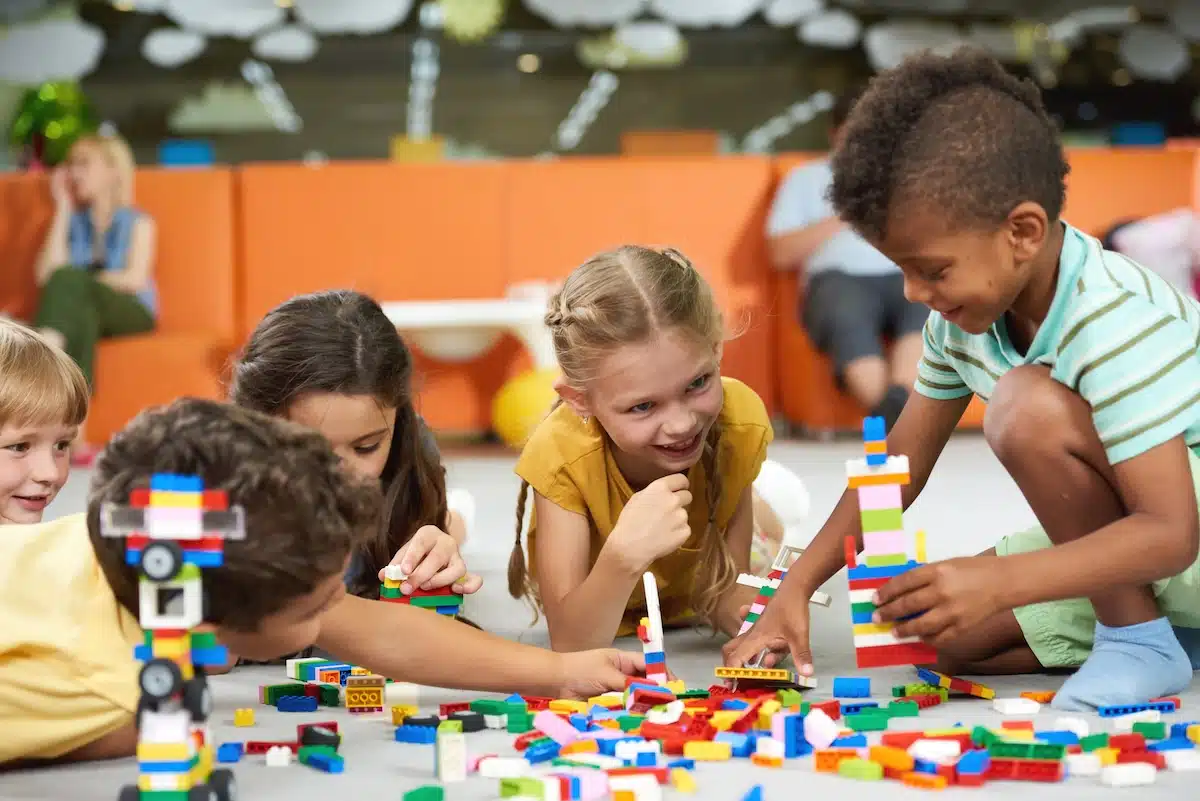Explaining autism to children who aren’t autistic can be challenging, but it’s important to do so in a way that is simple, clear, and compassionate. Kids are naturally curious, especially when they’re young, and they often notice when someone acts differently. Helping kids understand autism can go a long way in fostering empathy, acceptance, and inclusivity.
Related Article: Talking with Your Child About an Autism Diagnosis
Keep it Simple
Children need explanations that match their developmental level. Avoid complex terms, and instead, use language they can easily grasp.
- For Younger Kids: Keep it very basic. You might say, “Some people are born autistic, which means their brain works a little differently. This can make it hard for them to talk, play, or understand feelings the same way you do.”
- For School-Aged Kids: You can offer a bit more detail. For example, “Being autistic means that someone’s brain works differently. It can make it difficult for them to talk to others, understand what people mean, or handle things that upset them. But they also have special ways of seeing the world that are unique.”
Kelly Ernsperger, a social worker and owner of Autism Counseling & Behavior Consultation, offers a way to explain autism to a school-aged child: “You could say, ‘He is autistic. It’s not something you can catch; it’s something some people are born with. Autism affects how the brain works and can make it difficult for some people to talk, understand others, make friends, or calm down when they feel worried or stressed.’”
Ernsperger also recommends answering younger children’s questions directly. For instance, “Timmy flaps his hands because he was born autistic. When he is excited or stressed, he sometimes flaps his hands to help calm himself down.”

Focus on Being Different, Not Less
It’s key to explain that being autistic is just one way people can be different. These differences don’t make someone any less valuable or capable of being a friend.
-
- You could say: “Just like some people are really good at sports or drawing, people who are autistic might be really good at things like remembering details or noticing things others miss. But they might find things like talking or playing in a group harder.”
Teach Kindness and Understanding
Encourage your child to be kind, patient, and understanding toward their autistic peers. Help them see that everyone has their own strengths and challenges, and it’s important to be supportive.
- You could say: “If you notice someone acting differently, like flapping their hands, it’s not because they’re trying to be strange. They might be autistic and are doing what helps them feel comfortable. We should be kind and try to understand them, just as we would want others to be kind to us.”

Understanding differences
Teaching children to respect and understand differences is essential, especially when they comment on someone’s behavior as “weird” or unusual. Use these moments as opportunities to guide them toward empathy.
Dr. Sandy Burkhardt, a child psychologist with the Indy-based Children’s Resource Group, suggests how to handle these situations: “If your child comes home and says, ‘Billy acts weird,’ you can validate their observations by saying, ‘Yes, it’s too bad Billy had a meltdown because he didn’t like how the ketchup was on his hotdog.’ Then you can explain, ‘Some people have big reactions to minor things. In our family, we’re patient, we’re kind, and we believe that everyone is different.’”
The goal is to build empathy and help children understand others, even when their behavior seems unusual. By teaching compassion, children learn that instead of staring or judging, they should talk to a trusted adult about any questions or concerns.
Reinforce Family Values
Bring the conversation back to your family’s values, emphasizing the importance of kindness, acceptance, and inclusivity.
- You could say: “In our family, we believe that everyone deserves to be treated with respect and kindness, no matter how different they are. It’s important to be a good friend to everyone.”
Related Article: Handling the Holidays with Autism

Answer Questions Honestly
Children are naturally curious and may have questions. Answer them as honestly as you can, while keeping explanations appropriate for their age.
- Example: If a child asks, “Why doesn’t he look at me when I talk to him?” you might say, “Some autistic people find it hard to look at faces when they’re talking, but it doesn’t mean they aren’t listening.”

Remember, It’s an Ongoing Process
Talking to children about autism isn’t a one-time conversation. It’s an ongoing process where you continually reinforce the ideas of kindness, empathy, and understanding. Paula Butler, a Fishers mom of three, including an 8-year-old son who is autistic, sums it up nicely: “I hope parents of neurotypical kids explain autism with grace so that when the children of today encounter someone who is different from them, they treat them with the kindness and respect they deserve. I also hope kids take the opportunity to get to know someone who is autistic because our kids are amazing!”
Encourage Ongoing Conversations
Let your child know that it’s okay to come to you with more questions as they continue to learn about autism. This helps keep the lines of communication open.
- You could say: “If you ever wonder about something or have questions about autism, you can always talk to me. We can learn together.”
Model Inclusive Behavior
Kids learn a lot by watching the adults around them. Show them how to be inclusive and supportive of autistic people through your own actions.
- Example: Include autistic children in playdates or social activities and speak positively about them in front of your children.

Find a book to help explain autism
If you’re feeling a little stuck on how to talk to your child about autism, consider picking up a book (recommendations below). There are lots of picture books that tackle the topic in a way that’s easy for kids to grasp. Just make sure to choose a story that mirrors your child’s experiences. For instance, a book about a non-verbal autistic child might not be the best fit if the autistic child in your kid’s class is very verbal and social.
By following these tips, you can help your child develop a compassionate and understanding perspective on autism, fostering an inclusive environment where all children can thrive.
Our book recommendations:
Something’s Different About Andrew
Written and illustrated by Kyndal Gary, a senior at Columbus East High School.
Autism is a wide spectrum, which explains how people with it function. My type of autism is high-functioning, which helps me be more social and self-sufficient. However, other levels of autism affect other people’s social skills and ability to be self-sufficient.
Ethan’s Story: My Life with Autism
Written by Ethan Rice, illustrated by Crystal Ord.
A children’s book written by eight-year-old Ethan Rice, who is autistic. In this fully illustrated book, Ethan explains what autism means to him and why he feels blessed that God made him this way.
Leah’s Voice
Written by Lori Demonia, illustrated by Monique Turchan.
Leah’s Voice is a story that touches on the difficulties children encounter when they meet a child with autism or special needs. Siblings may find it hard to explain to their friends or feel disappointed when others aren’t understanding. This book tells the story of two sisters facing these challenges. Through her kindness and devotion, one sister teaches by example the importance of including everyone and showing acceptance.
Looking After Louis
Written by Lesley Ely, illustrated by Polly Dunbar.
A young girl sits next to a boy named Louis at school. Louis is autistic, but through imagination, kindness, and a special game of soccer, his classmates find a way to join him in his world. Then they can include Louis in theirs.
My Brother Charlie
Written by Holly Robinson Peete and Ryan Elizabeth Peete, illustrated by Shane Evans.
Actress and national autism spokesperson Holly Robinson Peete collaborates with her daughter on this book based on Holly’s 10-year-old son, who is autistic.
My Friend Has Autism
Written by Amanda Doering Tourville, illustrated by Kristin Sorra.
My friend Zack has a disability called autism. But that doesn’t matter to us. We talk about airplanes, build models, and enjoy hanging out at each other’s houses. I’m glad Zack is my friend!
Taking Autism to School
Written by Andreanna Edwards, illustrated by Tom Dineen.
These beautifully illustrated and fun-to-read storybooks simplify and normalize complicated childhood conditions, like autism. When read aloud, other children can identify why a peer may be treated differently and begin to empathize with them.



[…] READ ORIGINAL ARTICLE […]
[…] How to Explain Autism to Children Creating the Ultimate Sensory Room for Your Toddler Top Safety Tips and Products for Kids With Autism How to Stop Children with Autism Spectrum Disorder (ASD) from Wandering How Nutrition Impacts Children With Autism 12 Popular Games Adapted for Children with Autism 18 Social Skills Activities for Kids with Autism and Sensory Issues […]